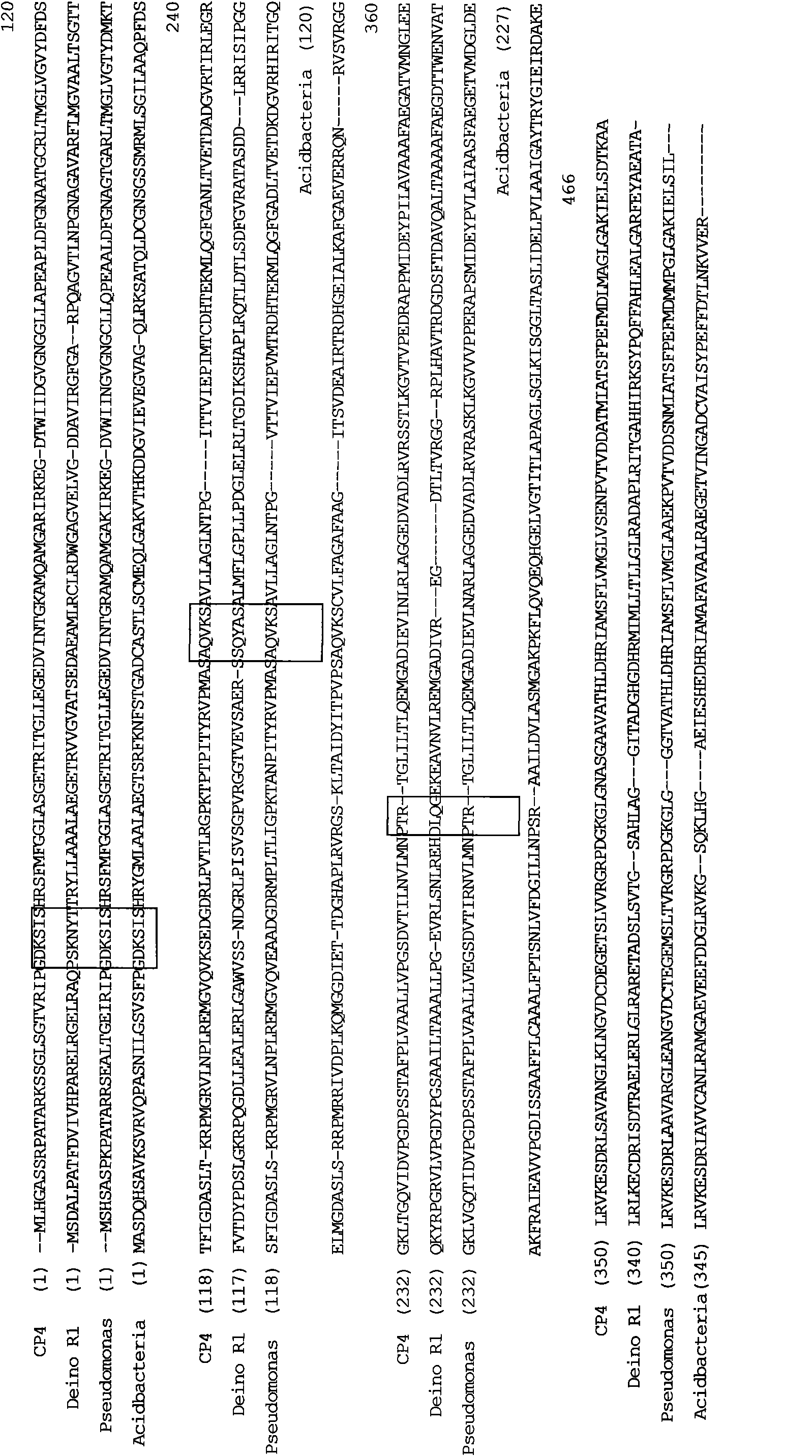Glyphosate-resistant gene and application thereof
A glyphosate-resistant gene technology, applied in application, genetic engineering, plant genetic improvement, etc., can solve the problem of not being able to directly provide glyphosate-resistant genes
- Summary
- Abstract
- Description
- Claims
- Application Information
AI Technical Summary
Problems solved by technology
Method used
Image
Examples
Embodiment 1
[0034] Embodiment 1, the resistance determination of anti-glyphosate bacteria
[0035] Deinococcus radiodurans is an ancient bacterium. In order to determine whether it has resistance to glyphosate, D. radiodurans was inoculated in M 63 medium containing 25mM glyphosate. The formula of M 63 medium is as follows: (per liter of M63: 13.6g KH 2 PO 4 , 2g (NH 4 ) 2 SO 4 , 0.5 mg FeSO 4 -7H 2 O, 2.4 mg MgCl 2 , 10g glucose, 10mg Thiamine-HCl and 25mg L-Proline, 40g agarose, pH7.0).
[0036] Since M63 does not contain aromatic amino acids, bacteria that can survive and grow on this medium can synthesize aromatic amino acids under high concentrations of glyphosate, and should be resistant bacteria. The results show that D.radiodurans can grow in M 63 medium with 25mM glyphosate, while the control Escherichia coli (E.coli) cannot grow under 25mM glyphosate, but can be cultured in M 63 without glyphosate basal growth. Therefore D. radiodurans may contain glyphosate res...
Embodiment 2
[0037] Embodiment 2, the cloning of resistance gene
[0038] A bacterial resistance to glyphosate may have multiple mechanisms. Such as possessing glyphosate-resistant EPSPS gene; having an enzyme that can degrade glyphosate; being able to limit the absorption of glyphosate, or possessing an enzyme that modifies glyphosate to inactivate glyphosate, etc. All genome studies of D. radiodurans were determined (Whtie O, Eisen J A, Heidelberg J F, et al. Genome sequence of the radio-resistant bacterium Deinococcus radiodurans R1. Science, 1999, 286: 1571-1577). Therefore, the discovery of glyphosate-resistant genes can start from the discovery of possible resistance genes in the genome. D. radiodurans contains a possible EPSPS gene. However, whether a bacterial EPSPS is resistant to glyphosate and the level of resistance cannot be predicted by the amino acid sequence of the EPSPS. Especially the anti-glyphosate ability of this type of novel EPSPS involved in the present invention...
Embodiment 3
[0040] The determination of the anti-glyphosate performance of embodiment 3, G7 gene
[0041] The glyphosate-resistant ability of Escherichia coli containing pMD18-T-G7 (containing G7 gene) vector was determined.
[0042] Escherichia coli containing pMD18-T-G7 and pMD18-T (empty vector, control) were first cultured in LB, when OD 600 When it reaches 0.6, take 0.2ml and centrifuge at 5000rpm for 1 minute, discard the supernatant. The precipitated cells were washed with M63 culture medium and then centrifuged, and then the precipitated cells were washed with the M63 culture medium containing 60mM glyphosate (every liter of M63: 13.6gKH 2 PO 4 , 2g (NH 4 ) 2 SO 4 , 0.5 mg FeSO 4 -7H 2 O, 2.4 mg MgCl 2 , 10g glucose, 10mg Thiamine-HCl and 25mg L-Proline, pH7.0) diluted to OD 600 0.02, then cultivated at 37°C (shaking table 250 rpm), and after 24 hours, measure the OD 600 . OD of clones containing pMD18-T-G7 600 is 0.84, while the control containing pMD18-T is only 0.05...
PUM
 Login to View More
Login to View More Abstract
Description
Claims
Application Information
 Login to View More
Login to View More - R&D
- Intellectual Property
- Life Sciences
- Materials
- Tech Scout
- Unparalleled Data Quality
- Higher Quality Content
- 60% Fewer Hallucinations
Browse by: Latest US Patents, China's latest patents, Technical Efficacy Thesaurus, Application Domain, Technology Topic, Popular Technical Reports.
© 2025 PatSnap. All rights reserved.Legal|Privacy policy|Modern Slavery Act Transparency Statement|Sitemap|About US| Contact US: help@patsnap.com


